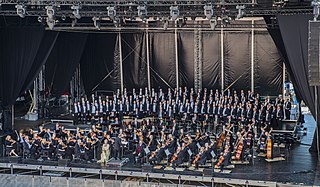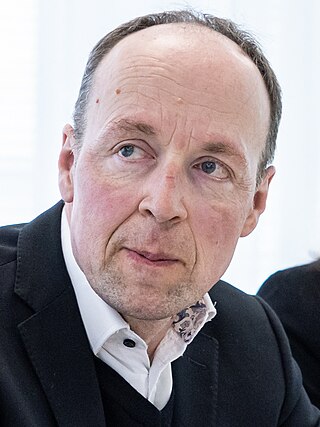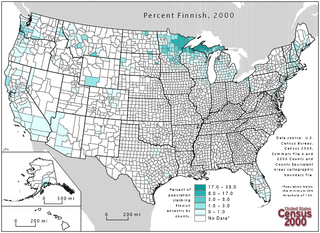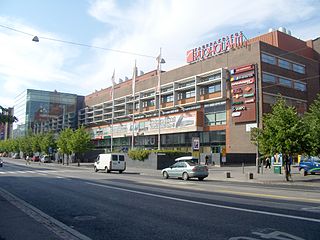 | |
 | |
| Coordinates | 60°9′53″N24°54′52″E / 60.16472°N 24.91444°E |
|---|---|
| Construction | |
| Built | 1940 |
| Opened | 1979 |
| Demolished | 1999 |
Lepakko or Lepakkoluola was a self-managed social centre and a music venue in Ruoholahti, Helsinki, Finland, functioning from 1979 to 1999.
 | |
 | |
| Coordinates | 60°9′53″N24°54′52″E / 60.16472°N 24.91444°E |
|---|---|
| Construction | |
| Built | 1940 |
| Opened | 1979 |
| Demolished | 1999 |
Lepakko or Lepakkoluola was a self-managed social centre and a music venue in Ruoholahti, Helsinki, Finland, functioning from 1979 to 1999.

The building was a paint company warehouse located at Porkkalankatu 1 in the Ruoholahti district of Helsinki, which had been built in 1940. [1] [2] It then became derelict and the City Council of Helsinki opened a hostel for alcoholics on 5 December 1967, in response to public outcry when several homeless alcoholics had frozen to death in the cold of winter. It hosted up to one thousand people and was called Liekkihotelli, or the Flame Hotel. [2] [3] [4]
Lepakko (Finnish for bat) was squatted in 1979 and used as a music venue, also providing practice rooms for bands, theatre rehearsal space and a dance school. In addition, a motorcycle gang had a workshop. [3] It took its name from the logo of the paint company which still was stencilled on the walls; it had been a butterfly, but the young people saw it more as a bat. [4] [2] It was the first public squat in Finland and its lifetime was extended by negotiating with the city council. [5] It was then leased for a small fee by the Elmu association. [1] The centre became a thriving self-managed social centre during the 1980s and 1990s. [6]
Lepakko was evicted and demolished in 1999. [1] It had been a foundational venue for Finnish punk music and hosted Radio City, a commercial radio station. [5]

Helsinki is the capital and most populous city in Finland. It is on the shore of the Gulf of Finland and is the seat of southern Finland's Uusimaa region. About 682,000 people live in the municipality, with 1.26 million in the capital region and 1.6 million in the metropolitan area. As the most populous urban area in Finland, it is the country's most significant centre for politics, education, finance, culture, and research. Helsinki is 80 kilometres (50 mi) north of Tallinn, Estonia, 400 kilometres (250 mi) east of Stockholm, Sweden, and 300 kilometres (190 mi) west of Saint Petersburg, Russia. Helsinki has significant historical connections with these three cities.
Helsingin Sanomat, abbreviated HS and colloquially known as Hesari, is the largest subscription newspaper in Finland and the Nordic countries, owned by Sanoma. Except after certain holidays, it is published daily. Its name derives from that of the Finnish capital, Helsinki, where it is published. It is considered a newspaper of record for Finland.

The Helsinki Metro is a rapid transit system serving the Helsinki capital region, Finland. It is the world's northernmost metro system. It was opened to the general public on 2 August 1982 after 27 years of planning. It is operated by Helsinki City Transport and Metropolitan Area Transport Ltd for Helsinki Regional Transport Authority and carries 92.6 million passengers per year.

Ruoholahti is a quarter in Helsinki, part of the Länsisatama neighbourhood and Kampinmalmi district. It is located in the southwestern part of the central city area of Helsinki, close to the Lauttasaari island, and it functions as the principal connection between the Helsinki city centre and the city of Espoo to the west. As of 2005 Ruoholahti is inhabited by approx. 3300 people. The Länsisatama port is also situated in Ruoholahti.

Länsimetro is an extension to the Helsinki Metro system in Finland, which opened on 18 November 2017. Länsimetro extends the system's two lines, M1 and M2, from Central Helsinki to the neighbouring city of Espoo. The new stretch continues the lines from the existing Ruoholahti station via the island of Lauttasaari, the Aalto University Otaniemi campus and Tapiola, the terminus of line M2. Line M1 continues further west to Matinkylä. Unlike previous extensions to the Helsinki Metro system, Länsimetro runs entirely underground. The second phase opened on 3 December 2022 and continues the line further west to Kivenlahti, near the municipal border of Kirkkonummi.

The Helsinki Philharmonic Orchestra is an orchestra based in Helsinki, Finland. Founded in 1882 by Robert Kajanus, the Philharmonic Orchestra was the first permanent orchestra in the Nordic countries. Today, its primary concert venue is the Helsinki Music Centre; the current chief conductor is Jukka-Pekka Saraste, who has held his post since the start of the 2023–24 season..

Nosturi was a culture and music hall and a nightclub in the Punavuori district of Helsinki, Finland. It was owned by the Association of Live Music.
Ari Peltonen, also known by the mononyms Paska and Anssi, is a Finnish radio persona, a cappella rock singer, reporter, writer, and television host.

Jätkäsaari is a peninsula and a quarter in Helsinki, the capital city of Finland. It is part to the Kampinmalmi district and Länsisatama neighbourhood. It was the site of the main container port in Helsinki until late 2008, when the harbour moved to the new facilities in Vuosaari. The terminals for passenger ferries to Tallinn and Saint Petersburg remain in Jätkäsaari at the West Harbour.

Jussi Kristian Halla-aho is a Finnish politician, currently serving as the Speaker of the Parliament of Finland since 2023. Halla-aho has served as a member of the Parliament of Finland from 2011 to 2014 and again since 2019, and as the leader of the Finns Party from 10 June 2017 to 14 August 2021. Previously, between 2014 and 2019, he was a member of the European Parliament, where he was part of the Identity and Democracy group.

The Helsinki Music Centre is a concert hall and a music center in Töölönlahti, Helsinki. The building is home to Sibelius Academy and two symphony orchestras, the Finnish Radio Symphony Orchestra and the Helsinki Philharmonic Orchestra.

Haloo Helsinki! is a pop rock band from Finland, founded in 2006. They have released five studio albums, all of which have reached the top ten on the Finnish Albums Chart. From 2007 to 2012, the band were signed to EMI Finland and as their principal collaborators switched to a Sony sub-label, Ratas Music Group, the band followed suit. In 2013, Haloo Helsinki! became the first Finnish artist whose four consecutive singles have peaked at number one on the Chart of commercial Finnish radio stations.

Hobitit is a nine-part Finnish live action fantasy television miniseries directed by Timo Torikka, originally broadcast in 1993 on Yle TV1.

Erkki Pohjanheimo is a Finnish television producer and director.
The city of Helsinki and the neighbouring city of Vantaa have plans for a radical expansion of the Helsinki tram network within the 2020s and 2030s that would more than double the length of the network from 2021. If completed, the plans would both extend the current tram lines and build new light rail lines.

Movement Now is an economically liberal political party in Finland.

American Finnish, Fingliska or Fingelska is a form of the Finnish language spoken in North America. It has been heavily influenced by the English language. American Finnish was used actively until the 1950s and after that it has been declining, and Finnish Americans have been switching to English. Even some basic phrases like tätsrait 'that's right' were borrowed from English. The form of speech was studied by Pertti Virtaranta in 1960, and the first American Finnish dictionary was made in 1992. It has influence from English both in syntax and vocabulary. In 2013 Finnish was spoken by 26,000 people in their homes. In the town of Oulu, Wisconsin, there are documented third-generation speakers of American Finnish, and in Stanton Township, Michigan, there are children who speak the language. American Finnish has also retained loanwords from Swedish which modern Finnish lost.

The Ruoholahti shopping centre is a shopping centre in the district of Ruoholahti, Helsinki, Finland. It is located in the premises of a former Alko bottling facility, where it was opened in 2003.

Dance House Helsinki is a theatre building in the Ruoholahti district of Helsinki, Finland, next to the Kaapelitehdas building.

Kai Martin Edvard Setälä was a Finnish physician and professor of pathological anatomy at the University of Helsinki. Through his daughter Christel, he was the maternal grandfather of Alexander Stubb, the 13th President of Finland. Setälä himself was the great-nephew of professor E. N. Setälä (1864–1935), the Counsellor of State, the Chairman of the Senate of Finland and co-author of the Finnish Declaration of Independence.